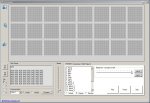If anyone's interested in building an LED cube that they can control with a PICAXE microcontroller, my daughter and I have just made one from a kit. I'm happy to say that it works fine with PICAXE (we're using HSEROUT at 57600 baud) and we are now having fun writing programs for it.
The problem with the particular kit we bought (which I think is available from a variety of sources) is that all the instructions are in Chinese so we decided to write a blog about how to build it (or at least how we built ours). The blog can be found here:
http://8x8x8ledcube.blogspot.co.uk/
Although we have got the thing working almost perfectly, we do have one mystery to solve - how to 'reset' the cube so that it is expecting the next byte to be a command (not data). If we run it with the software provided, the cube magically seems to know that the first command it receives is indeed a command and not data. We can get around this by simply resetting the cube and PICAXE chip at the beginning of the sequence but it frustrates me that it's clearly possible to do - I just can't work out how. If anyone can guess how it is done please let me know.
Cheers,
Nigel
PS I must emphasise that I have nothing to do with anyone involved in the manufacture or sale of the kit and there may well be better ones out there.
The problem with the particular kit we bought (which I think is available from a variety of sources) is that all the instructions are in Chinese so we decided to write a blog about how to build it (or at least how we built ours). The blog can be found here:
http://8x8x8ledcube.blogspot.co.uk/
Although we have got the thing working almost perfectly, we do have one mystery to solve - how to 'reset' the cube so that it is expecting the next byte to be a command (not data). If we run it with the software provided, the cube magically seems to know that the first command it receives is indeed a command and not data. We can get around this by simply resetting the cube and PICAXE chip at the beginning of the sequence but it frustrates me that it's clearly possible to do - I just can't work out how. If anyone can guess how it is done please let me know.
Cheers,
Nigel
PS I must emphasise that I have nothing to do with anyone involved in the manufacture or sale of the kit and there may well be better ones out there.
Last edited:

